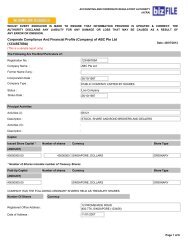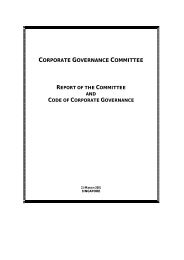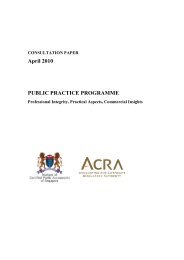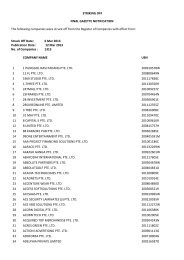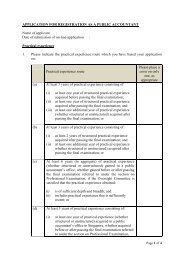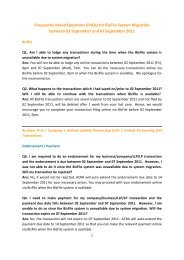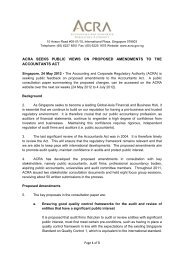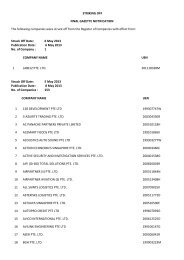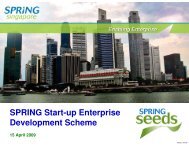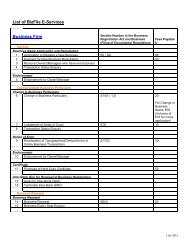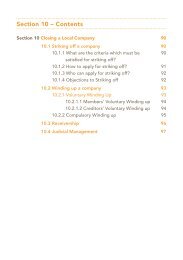Exposure Draft - ACRA
Exposure Draft - ACRA
Exposure Draft - ACRA
You also want an ePaper? Increase the reach of your titles
YUMPU automatically turns print PDFs into web optimized ePapers that Google loves.
CODE OF PROFESSIONAL CONDUCT AND ETHICS FOR PUBLIC ACCOUNTANTS<br />
290.7 In a direct reporting assurance engagement the public accountant in public practice<br />
either directly performs the evaluation or measurement of the subject matter, or obtains<br />
a representation from the responsible party that has performed the evaluation or<br />
measurement that is not available to the intended users. The subject matter information<br />
is provided to the intended users in the assurance report.<br />
290.8 Independence requires:<br />
Independence of Mind<br />
The state of mind that permits the expression of a conclusion without being affected by<br />
influences that compromise professional judgment, allowing an individual to act with<br />
integrity, and exercise objectivity and professional skepticism.<br />
Independence in Appearance<br />
The avoidance of facts and circumstances that are so significant that a reasonable and<br />
informed third party, having knowledge of all relevant information, including<br />
safeguards applied, would reasonably conclude a firm‘s, or a member of the assurance<br />
team‘s, integrity, objectivity or professional skepticism had been compromised.<br />
290.9 The use of the word ―independence‖ on its own may create misunderstandings.<br />
Standing alone, the word may lead observers to suppose that a person exercising<br />
professional judgment ought to be free from all economic, financial and other<br />
relationships. This is impossible, as every member of society has relationships with<br />
others. Therefore, the significance of economic, financial and other relationships should<br />
also be evaluated in the light of what a reasonable and informed third party having<br />
knowledge of all relevant information would reasonably conclude to be unacceptable.<br />
290.10 Many different circumstances, or combination of circumstances, may be relevant and<br />
accordingly it is impossible to define every situation that creates threats to<br />
independence and specify the appropriate mitigating action that should be taken. In<br />
addition, the nature of assurance engagements may differ and consequently different<br />
threats may exist, requiring the application of different safeguards. A conceptual<br />
framework that requires firms and members of assurance teams to identify, evaluate and<br />
address threats to independence, rather than merely comply with a set of specific rules<br />
which may be arbitrary, is, therefore, in the public interest.<br />
A Conceptual Approach to Independence<br />
290.11 Members of assurance teams, firms and network firms are required to apply the<br />
conceptual framework contained in Section 100 to the particular circumstances under<br />
consideration. In addition to identifying relationships between the firm, network firms,<br />
members of the assurance team and the assurance client, consideration should be given<br />
to whether relationships between individuals outside of the team and the assurance<br />
client create threats to independence.<br />
290.12 The examples presented in this section are intended to illustrate the application of the<br />
conceptual framework and are not intended to be, nor should they be interpreted as, an<br />
35



